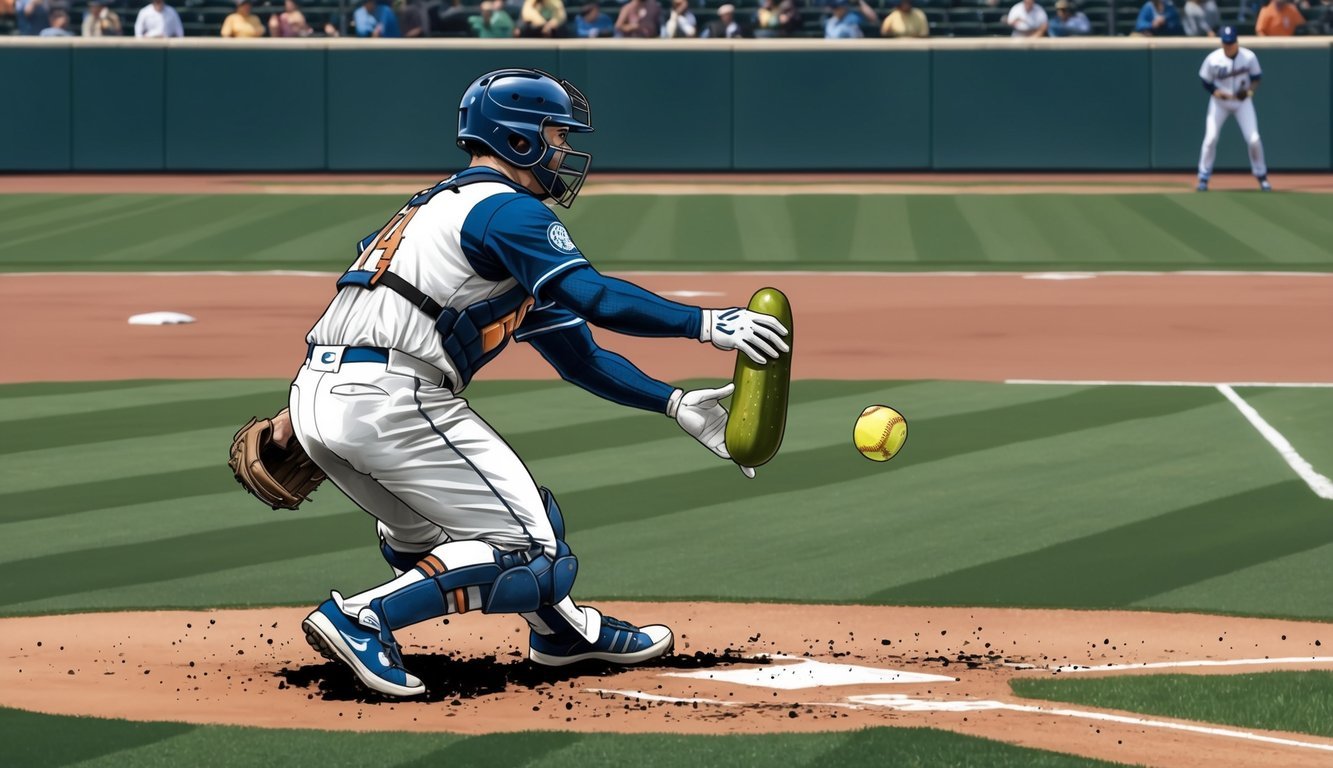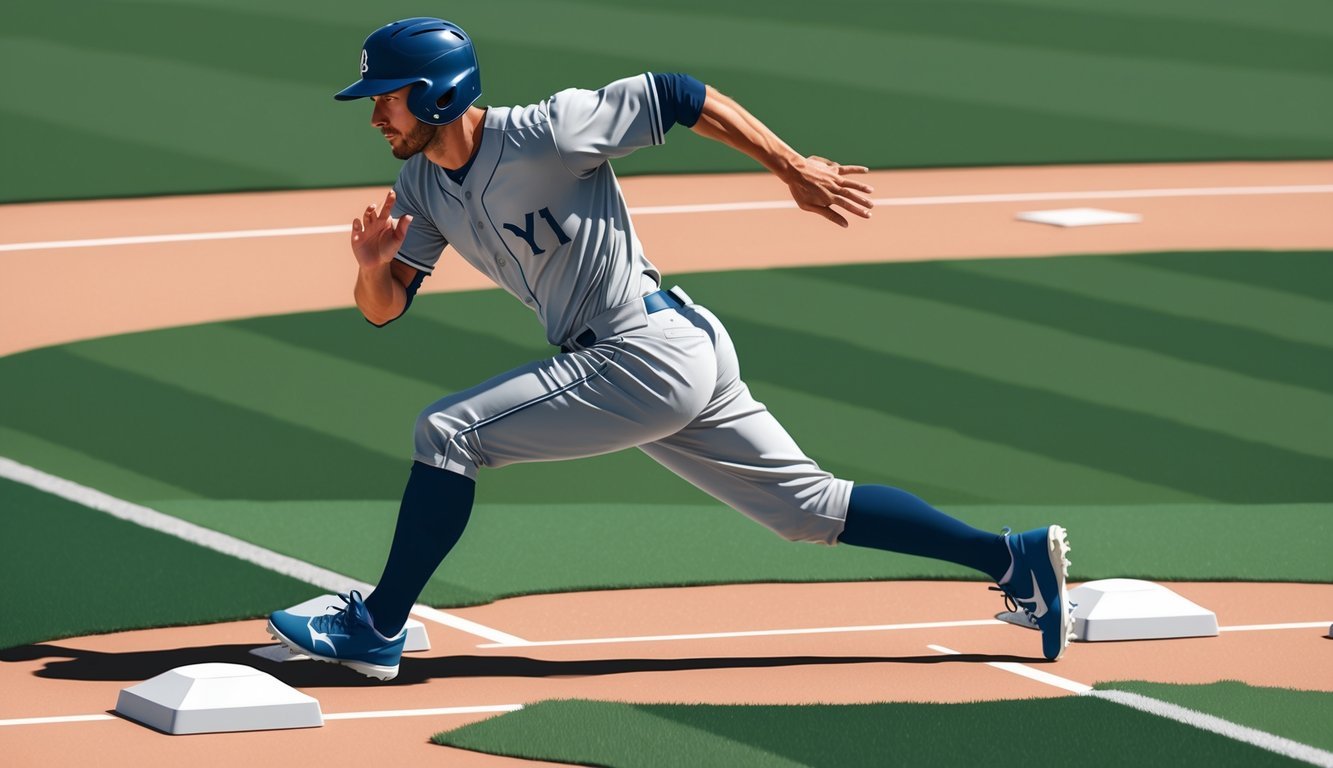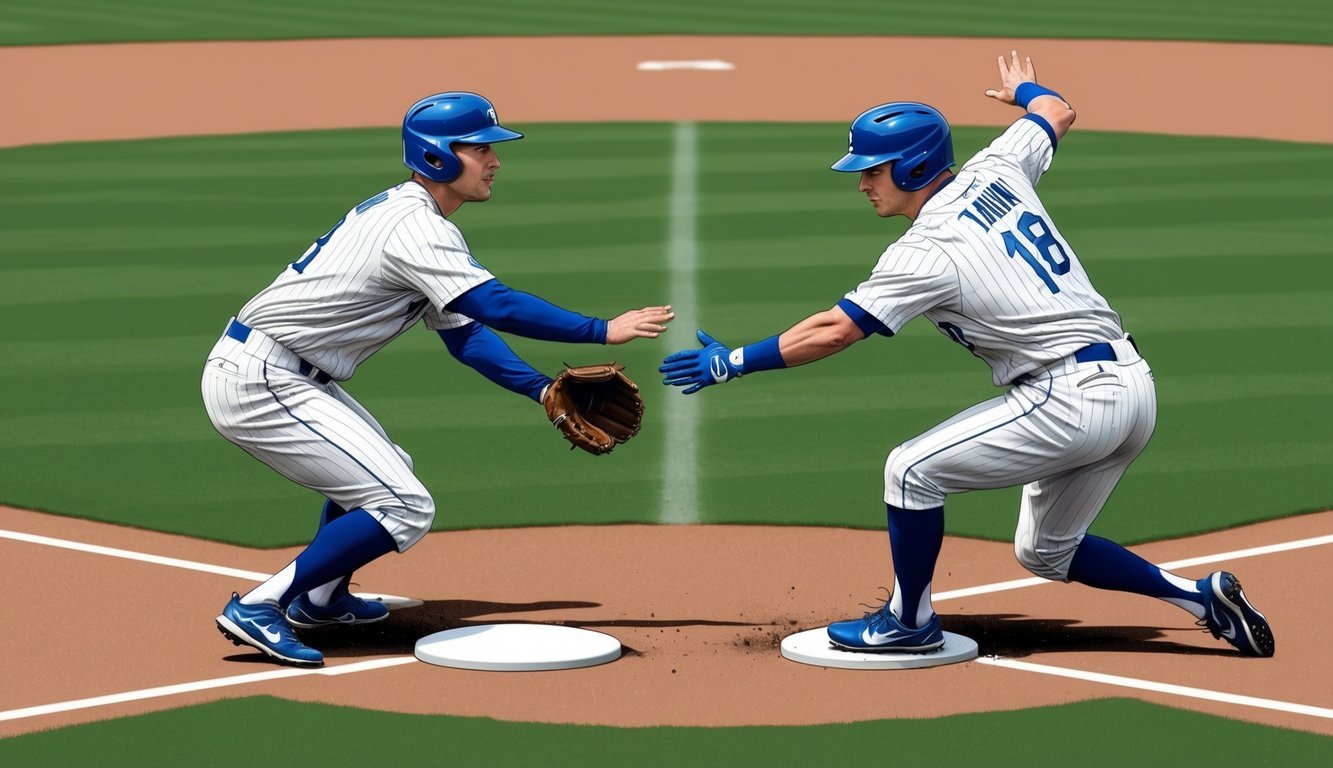Baseball is full of unique terms and situations that make the game exciting.
One such scenario is the “pickle” – a tense moment when a baserunner finds themselves trapped between two bases.
A pickle, also known as a rundown or hotbox, occurs when fielders attempt to tag out a runner caught between bases.
The origin of the term “pickle” in baseball dates back to England, where being “in a pickle” meant being in a tough spot.
This perfectly describes the predicament of a baserunner during a rundown.
MLB games have featured many memorable pickle plays, showcasing the quick thinking and agility required by both runners and fielders.
Executing a successful pickle play demands skill and strategy.
Fielders must coordinate their movements and throws to prevent the runner from advancing, while the runner tries to evade tags and reach a base safely.
This cat-and-mouse game adds an element of suspense and excitement to America’s favorite pastime.
Understanding the Baseball Pickle
A baseball pickle puts runners in a tight spot between bases, testing both offensive and defensive skills.
This exciting play requires quick thinking and teamwork to resolve.
Defining the Pickle Situation
A pickle occurs when a baserunner gets caught between two bases.
The runner finds themselves in a tricky position, trying to avoid being tagged out while the defense works to secure the out.
This scenario often unfolds after a failed steal attempt or when a batter gets caught off-base.
The runner must use speed and strategy to escape, while fielders coordinate to trap them.
Pickles create suspense and excitement on the field.
They can shift momentum and spark rallies if the runner escapes, or boost team morale with a well-executed defensive play.
The Role of Fielders and Runners
In a pickle, fielders aim to tag the runner out before they reach safety at either base.
The defense typically involves multiple players working together to close off escape routes.
Infielders toss the ball back and forth, trying to corner the runner.
They must stay alert and make quick, accurate throws to prevent the runner from advancing.
The trapped runner’s goal is to reach a base safely.
They use fakes, hesitations, and sudden bursts of speed to confuse the defense.
Smart baserunning can turn a pickle into an opportunity to advance.
Successful pickle plays require practice and communication.
Teams often drill these situations to sharpen their skills and coordination.
Rules and Regulations
Pickle plays in baseball have specific guidelines to ensure fair competition.
These rules cover how rundowns are conducted and what constitutes interference or obstruction during play.
Fielders must execute quick and strategic throws to tag the runner before they can safely reach a base.
Meanwhile, baserunners rely on agility and timing to escape the rundown and advance.
Understanding what is a balk is also crucial, as an illegal move by the pitcher can impact the dynamics of a pickle play.
Rundown Rules and Exceptions
A rundown, or pickle, occurs when a baserunner is caught between bases.
Fielders must tag the runner to record an out.
Runners can’t leave the baseline to avoid tags.
If they do, they’re out.
Two runners can’t occupy the same base simultaneously.
Fielders can’t block bases without the ball.
This is obstruction and the runner is awarded the base.
Errors during a rundown, like overthrows, can benefit the runner.
They may advance at their own risk.
Tags should be made with the ball securely in hand or glove.
A common technique is to hold the ball in the throwing hand while wrapping the glove around it for protection.
Interference and Obstruction
Interference happens when an offensive player hinders a fielder’s attempt to make a play.
This results in the offending player being called out.
Examples include a runner colliding with a fielder or a batter blocking the catcher’s throw.
Obstruction occurs when a fielder impedes a runner’s progress without possession of the ball.
The obstructed runner is typically awarded the base they would have reached without the obstruction.
Coaches can’t physically assist runners during a rundown.
This is considered interference.
Baseline paths are established when a tag attempt begins.
Runners deviating more than 3 feet from this path to avoid a tag are out.
Strategic Approaches in a Pickle

A pickle situation in baseball demands quick thinking and precise execution from both fielders and runners.
Success hinges on split-second decisions, coordinated teamwork, and anticipation of the opponent’s moves.
Fielder Strategies and Communication
Fielders must work together seamlessly to trap the runner.
Infielders should position themselves strategically, creating a tight net around the baserunner.
Quick, accurate throws are crucial to maintain pressure.
Verbal cues like “I got ball!” or “Coming to you!” help coordinate movements.
Defenders should fake throws to keep the runner guessing.
This tactic can cause hesitation or false steps.
Fielders must also be ready for unexpected moves, like a sudden sprint or reversal of direction by the runner.
Tags should be applied low and firm.
Fielders need to protect the ball while reaching for the runner, reducing the risk of errors or dropped balls during the tag attempt.
Runner Anticipation and Responses
Runners caught in a pickle face a challenging situation but aren’t without options.
They should focus on extending the rundown as long as possible, tiring out fielders and increasing chances for a mistake.
Quick changes of direction can throw off defenders’ timing.
Runners should watch for wide throws or fumbles, ready to capitalize on any errors.
Faking a move in one direction before sprinting the opposite way can create openings.
Reading fielders’ body language is key.
A slight shoulder turn or grip adjustment might telegraph their next move.
Runners can also look for gaps in the defensive formation to exploit.
Smart baserunners use the rundown as a distraction, allowing other runners to advance.
This strategy can turn a tricky situation into a scoring opportunity for the team.
Pickle Drills and Practice Techniques

Mastering pickle plays requires dedicated practice and specific drills.
Fielders and runners alike benefit from targeted exercises that simulate real-game scenarios and improve reaction times.
Essential Drills for Fielders
Fielders can sharpen their pickle skills with focused drills.
The classic three-person drill involves two fielders and a runner.
Fielders stand about 30 feet apart, simulating bases.
They practice quick, accurate throws while a runner attempts to evade tags.
Another effective drill is the rapid-fire pickle.
Multiple runners start between bases, with fielders working to tag them out quickly.
This drill improves fielders’ decision-making and coordination.
Coaches often set up relay races where teams compete to complete the most successful pickles in a set time.
This adds a fun, competitive edge to practice.
Training Runners to Evade Tags
Runners need agility and smart decision-making to escape pickles.
A popular drill has runners practice sudden direction changes between cones.
This improves their ability to dodge tags and reverse course quickly.
The “freeze” drill helps runners read fielders’ movements.
Runners move between bases, freezing when coaches blow a whistle.
This teaches them to stop abruptly and assess the situation.
Reaction drills are crucial.
Runners start in a pickle situation and must respond to coaches’ verbal or visual cues.
This drill enhances split-second decision-making skills.
Many big leaguers use mirror drills to perfect their jukes and dekes.
Runners face a partner and mimic their movements, improving body control and unpredictability in pickle situations.
Famous Pickles in Baseball History

Baseball has seen its share of thrilling pickle plays that have left fans on the edge of their seats.
These moments of baserunning drama have produced some unforgettable highlights in MLB history.
Notable Pickle Plays and Players
The 1992 World Series featured a classic pickle play between the Toronto Blue Jays and Atlanta Braves.
With the score tied, a Blue Jays runner found himself trapped between bases.
Quick thinking and nimble footwork allowed him to escape, leading to a crucial run.
In 2014, the Pittsburgh Pirates executed a rare triple pickle.
Three Mets runners ended up caught between bases simultaneously.
The Pirates’ defense stayed calm, methodically tagging out all three for a unique triple play.
Rickey Henderson, known for his baserunning prowess, often turned pickles into opportunities.
His speed and instincts helped him escape seemingly impossible situations, frustrating opposing teams.
Josh Harrison’s Legendary Escapes
Josh Harrison of the Pittsburgh Pirates became famous for his pickle escapes.
In a 2014 game against the New York Mets, Harrison found himself in a pickle between third and home.
He dodged five tag attempts, zigzagging between bases.
Harrison’s incredible agility and quick changes of direction left the Mets’ fielders bewildered.
After a 20-second chase, he dove safely into home plate, scoring a run.
This play earned Harrison national attention and highlighted his unique talent for escaping tight spots.
He repeated similar feats throughout his career, making pickle situations his specialty in the major leagues.
